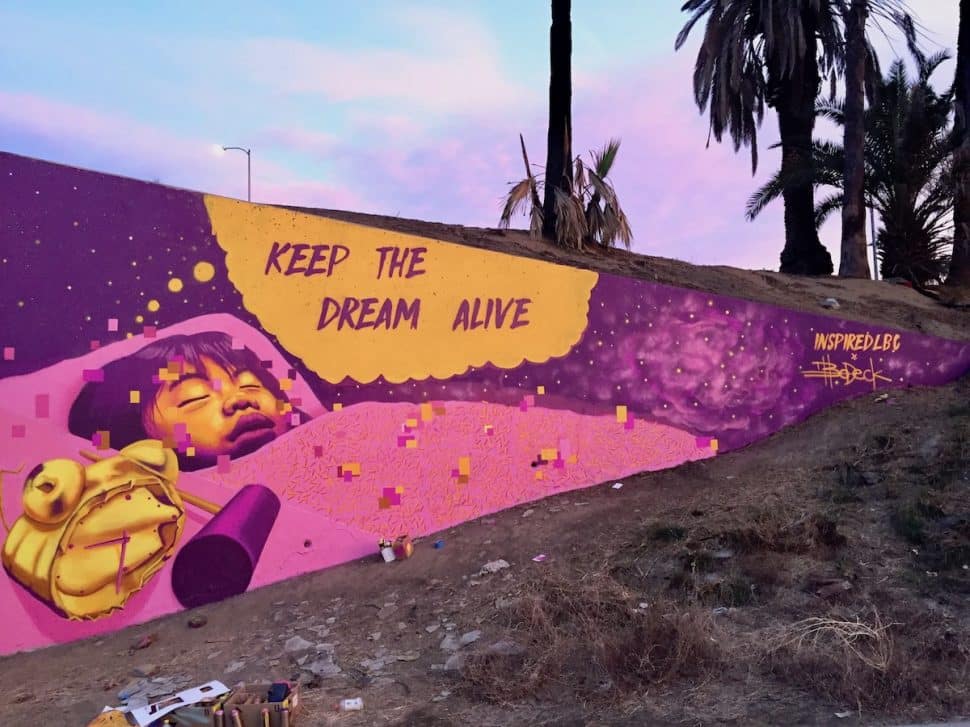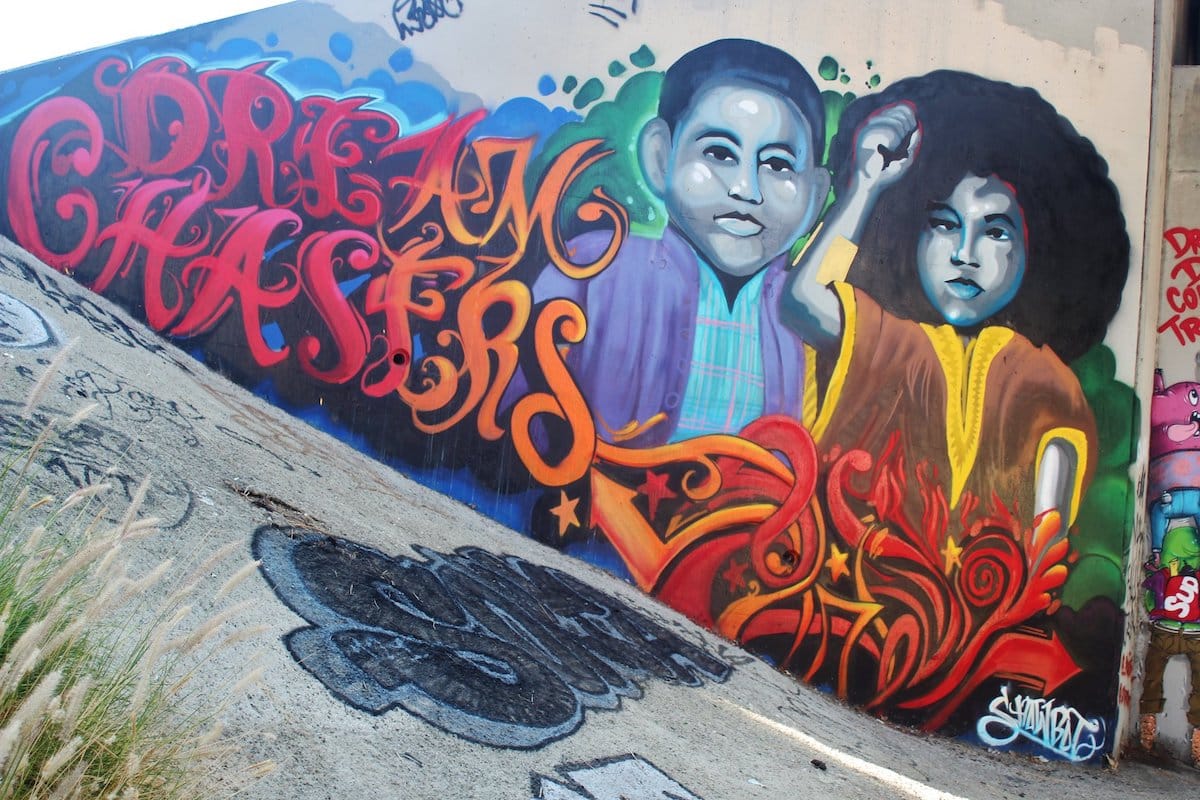[easy-image-collage id=999941754]
Top: StreetArtistInResidence murals and graffiti under the Sixth Street bridge in Long Beach on Sep. 9, 2018. Photo by Matt Cohn. Bottom: The now painted tunnel under the Sixth Street bridge in Long Beach on March 7, 2019. Photo by Asia Morris.
What was once a mish-mashed collage of murals and graffiti on the tunnel walls underneath the Sixth Street 710 off-ramp and Shoreline Drive, is now a stark gray unLongBeach-like space, save for a handful of recently scrawled tags.
Footsteps crunching on glass echo against the walls and criss-crossing bridges that make up the “roof” of this urban cathedral that was, until recently, considered a space where artists could paint freely.
The Public Works Department recently covered the art, due to “excessive and continual graffiti”, a decision that has angered some artists for disrupting what was considered a thriving art ecosystem, yet has satisfied others who considered it defacement.
Sixth Street Bridge murals suddenly covered; defacing graffiti blamed
Many of the murals that were covered were commissioned by the nonprofit StreetArtistInResidence with 1st District Councilwoman Lena Gonzalez and painted by and about young people protected by DACA, several in response to President Donald Trump’s decision to overturn the policy.
Some of the murals were not related to DACA and stood as hidden gems created by local and visiting artists over the last two years.
However, what Public Works deemed an overwhelming amount of graffiti was, to many of the artists whose murals were covered, an expected consequence of painting in a public space.
“It’s the ecosystem of our community, everything has an evolution,” said “GoopMassta”, a nationally-known artist who painted several pieces there. “I was a tag guy, then I saw these beautiful murals in every city, so you wanna grow, you wanna learn.”
[easy-image-collage id=999941841]
Murals and graffiti under the Sixth Street bridge in Long Beach. Sep. 9, 2018 that have no been painted over. Photos by Matt Cohn. Left, art by WRDSMTH and Andrea LeHue; bottom, art by Charmaine Olivia and Alec De Marco.
While Jennifer Carey of Public Works said the city typically works with muralists and organizers when issues like graffiti arise, it seems many artists were not aware that these particular walls would be wiped clean, so to speak.
It was in agreement with StreetArtistInResidence that the city determined that since the murals would continue to be defaced, and the time and expense to restore them would only increase, it would be best to cover them.
No mention that the graffiti presented might incite violence or was in any way gang related was brought up, just that the public was concerned.
If anything, the graffiti seemed to spur the creation of more art, with many of the artists going on their own accord to restore their works and add new ones, including Long Beach artist Erick Guadarrama, who said he was a part of the first round of artists to paint the DACA murals.
He revisited his piece, a depiction of his six-year-old self dreaming of becoming an artist as a first-generation Mexican immigrant, on multiple occasions to paint over the graffiti.
[easy-image-collage id=999941760]
Left: Erick Guadarrama’s mural in the Sixth Street tunnel. The mural has since been painted over by the city. Courtesy the artist. Right: Graffiti covers Erick Guadarrama’s mural under the Sixth Street bridge on Sep. 9, 2018. Photo by Matt Cohn.
Long Beach-based graffiti artist “Gomse One”, who also painted one of the original DACA murals, said when his mural was defaced he brought in artists from Los Angeles, the East Coast and Southeast Asia to paint an underwater-themed mural in the tunnel, unfortunately it was one of the first pieces the city covered up, he said.
“It’s unfortunate because we had a lot of people giving us good feedback and a handful of good artists coming out, we used all our own paint, so on my end I was pretty let down the city would take down our wall first,” he said.
Josh Garcia, founder of local arts organization Inspired LBC, collaborated with local artist Bodeck Hernandez to bring to life one of the Dreamers-inspired murals completed by early 2018.
With experience in both worlds, graffiti and permitted mural-making, Hernandez said both are considered street art and “harmoniously coexist in the public space open for the audience’s interpretation for either adoration or disdain.
“It hurts when my pieces get tagged over, but then again that’s just how the street game goes—the streets always wins. I just hope it’s better than the one they’re replacing and not just some petty toy’s tags.”
Toy is the term for an inexperienced or unskilled graffiti artist.

One of the Dreamers-inspired murals, painted by Bodeck Hernandez and Josh Garcia. The mural and recent tagging has since been painted over by the city. Courtesy Josh Garcia.
“As far as the city is concerned, it’s solely up to the property owner what they’d like to do with their property,” Hernandez said. “If it’s government property, they can go over it legally. If it’s a private owner, the city should only intervene if the art piece is affecting the community in a negative way.
That’s what makes street art beautiful: legal, permitted pieces or intricate graffiti, it sets the tone for the public to engage in conversation and community.”
Garcia is in the camp that the covering of the murals and graffiti provides a fresh slate.
“Once graffiti artists came through it became an open playground, which sucked because we put in a lot of time and intention, along with all the other artists,” Garcia said. “But for street art, that’s the risk that’s taken. It’s better to have it cleaned up than graffiti everywhere.”
But the city may have unwittingly encouraged the opposite of what they were trying to achieve; on Thursday multiple tags had already appeared on the tunnel walls.
GoopMassta, who was born in New York, raised in Miami and now lives in Long Beach, said he used to take artist friends from out of town to paint under the Sixth Street bridge.

Mural collaboration between GoopMassta, Two Dimes, Miser, Villatose and Frankzilla under the Sixth Street bridge in Long Beach, Feb. 11, 2019. The mural has since been painted over by the city. Courtesy GoopMassta.
“It’s like your city is thriving in the arts, yet you wanna cut off the arts,” he said. “But every time they chop down ‘our thing’ we grow stronger. I bet you, go back in a week and you’ll see that life hasn’t stopped.”
GoopMassta noted the tunnel used to be a tour destination and has seen many a bicyclist ride through to admire the murals. He hands out stickers and introduces himself and other artists to visitors if he’s around during these events.
“I want that area to be a free place to express [ourselves], to invite other cultural peeps, to invite other artists from different parts of town to enjoy a safe place to be,” he said.
3D virtual tour by artist and tech-master Craig Sauer showing the StreetArtistInResidence murals painted in response to Trump’s decision to overturn DACA. Feb. 28, 2018. The murals have since been painted over by the city after being defaced.

